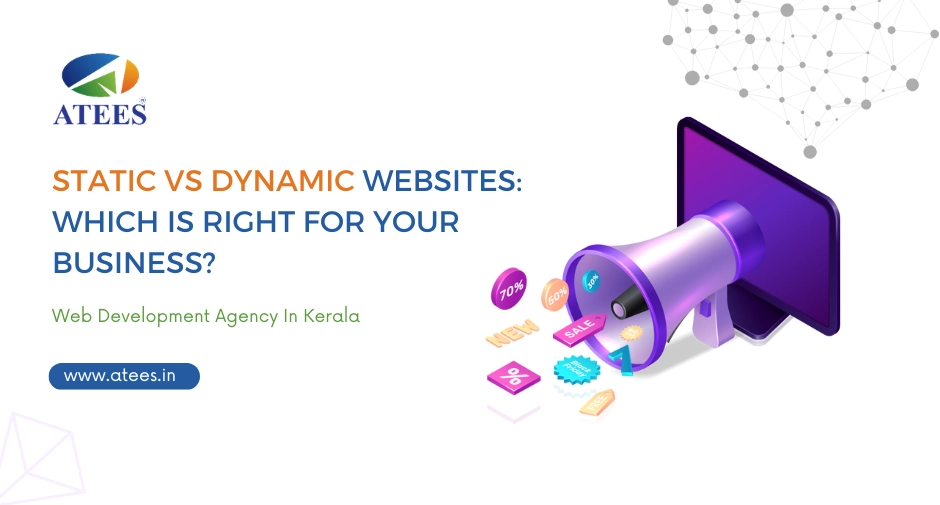
Nowadays, websites are vital to commercial success. Customers visit the company website to acquire personal knowledge, even if your firm does not rely primarily on Internet sales.
Website construction is unquestionably important; nonetheless, the development process necessitates a variety of complexities and strategic methods. Similarly, one of the most important decisions you’ll make while creating a website is whether to use a static or dynamic approach.
What is a Static Website?
A static website is the simplest type of website, with set content that does not change unless explicitly updated. In other words, any person who views a static homepage receives the same information, making it simple to create and deploy. Static websites are often designed with HTML, CSS, and, in some cases, JavaScript to render content in the user’s browser.
Advantages of Static Websites:
- Speed: Static websites run quicker than dynamic websites since they are pre-built and do not rely on server-side processing for every request. This makes them suitable for displaying content such as portfolios, brochures, or personal blogs.
- Cost-Effective: Static websites are less expensive to construct since they do not require complicated back-end development or databases. If your website has only a few pages of material and limited interactivity, a static website may be the most cost-effective option.
- Security: Because static websites do not use databases or server-side scripting, they are less vulnerable to assaults like SQL injection, making them safer than dynamic websites.
- Simplicity: Static websites are easy to manage. If the website content is unlikely to change regularly, maintaining a static site is simple and does not need sophisticated technological knowledge.
Disadvantages of Static Websites:
- Limited Functionality: While static websites are fantastic for displaying material, they lack the sophisticated functionality and interaction of dynamic websites. This may be restricted if you want capabilities such as user registration, real-time updates, or content management.
- Scalability Issues: As your company expands and your website’s content becomes more complicated, maintaining and upgrading a static website can become challenging.
- No Personalization: Static websites cannot provide personalised experiences depending on user behavior or choices. If you wish to give personalized information or connect with consumers on a deeper level, a static website may not be appropriate.
What is a Dynamic Website?
A dynamic website is a more advanced sort of website in which the content changes based on user input, choices, or live data. Dynamic websites, as opposed to static websites, create material dynamically using server-side scripting languages like PHP, Python, or JavaScript. They may also include a material Management System (CMS), such as WordPress, which enables non-technical users to easily manage material.
Advantages of Dynamic Websites:
- Interactivity and Personalization: Dynamic websites provide increased interaction with users. You may include features like as online forms, user accounts, e-commerce capability, and real-time content changes. Dynamic websites are also useful for tailoring the user experience depending on preferences, geography, or browsing habits.
- Material Management Ease: Using a CMS like WordPress makes it much easier to update and manage material. Dynamic websites enable business owners and marketing teams to make changes without touching the code. This makes dynamic websites perfect for organizations that require frequent content changes or wish to keep a blog.
- Scalability: As your company expands, dynamic websites can accommodate increasingly complicated features and vast volumes of material. With dynamic components, your website may develop as needed without having to start from scratch.
- SEO Advantages: Dynamic websites may incorporate a variety of SEO tools and plugins, allowing for more effective optimization and content targeting. For example, WordPress offers several SEO plugins that produce metadata, manage sitemaps, and boost overall SEO performance.
Disadvantages of Dynamic Websites:
- Increased complexity: Dynamic websites demand more development time and skill. A dynamic website is often more complicated to design than a static one since it requires the use of databases and server-side programming.
- Higher Costs: Because of the intricacy required in building and maintaining a dynamic website, the overall cost is more than for a static website. Additionally, continual server maintenance and database administration might raise the overall cost of ownership.
- Slower Loading Speed: Because dynamic websites employ server-side scripting and databases, they may take longer to load than static pages. This can be minimized using caching and optimization tactics, but it’s worth considering, especially for those with slower internet connections.
- Security Risks: Dynamic websites based on databases and server-side programming are more vulnerable to hackers. You must put in place robust security policies to secure sensitive data and assure the safety of user interactions.
Which is Right for Your Business?
When deciding whether to choose a static or dynamic website for your business, consider the following factors:
- Content Nature
- Static Website: Suitable for websites with consistent content that do not require regular modifications. This is an excellent choice for firms that just need to display minimal information, such as portfolios, brochures, or landing pages.
- Dynamic Websites: These are ideal for organizations that demand real-time changes, tailored information, or user interaction. Dynamic websites are perfect for hosting blogs, e-commerce storefronts, and interactive programs.
- Budget and Expertise
- Static Website: A static website is less expensive and easy for novices to create. Because development is less difficult, the cost is cheaper, making it an attractive alternative for small enterprises with limited finances or those seeking a minimal online presence.
- Dynamic Website: Due to its intricacy, this type of website requires a larger budget. Building and maintaining a dynamic website needs significant technical knowledge, including programming, database administration, and continuing security measures. Additional features come at a higher cost but provide more capability in return.
- Scalability and Growth
- Static Website: Scaling a static website might be difficult as your company expands. Adding new material, features, or pages might be difficult to handle manually.
- Dynamic websites: Provide improved scalability. They enable easy growth as your content and user base increase. Content management systems (CMS) make it easy to add new sections, pages, and features without changing the site’s architecture.
- Interactivity Requirements
- Static websites often have minimal interactive capabilities, making them perfect for firms that merely need to convey information and do not require user participation or real-time capability.
- Dynamic Website: Offers extensive interaction, making it ideal for organizations that require features like user registration, online forms, e-commerce functionality, and individualized user experiences.
- Maintenance Considerations
- Static website: Static sites require less maintenance. Once constructed, there is no need for updates or upkeep, unless the material has to be changed. This makes it a low-maintenance option for businesses that do not require frequent updates.
- Dynamic website: Requires regular updates to both the content and the underlying system. Dynamic websites also require regular security assessments to safeguard user data and maintain seamless operation. For organizations with expanding content or a user base, continuous maintenance is crucial.
The choice between a static and dynamic website is ultimately determined by your business objectives, budget, and desired user experience. Static websites are great for organizations that want a quick, easy, and secure internet presence. They’re ideal for portfolios, tiny informative websites, and enterprises with little content.
Dynamic websites, on the other hand, offer more functionality, engagement, and administration flexibility. They are better suited to organizations that need regular updates, customer involvement, and complex services like e-commerce.
Hence, If you’re looking for a Web Design Agency in Thrissur or a Web Design Agency in Kerala, you should speak with specialists who can help you find the ideal solution for your requirements. WordPress Development in Kerala is another good option for businesses who prefer flexibility and scalability from their websites.


